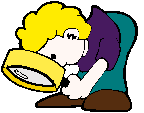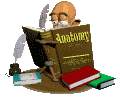|
|
Chapter
2: Basic Chemistry
Anatomy
& Physiology
Marymount High School
a
journey into the inner workings of the human body!
|
|
|
Teacher:
Judith S. de Nuño
jdenuno@mhs-la.org
|
WebSites
http://members.home.net/jdenuno
Science
at Marymount
|
Office
Hours
Daily
at Lunch in the
Science
Patio
|
Cyber
Office Hours
AIM:
teachsci23

|
|
|
|
Food
Diary: The Chemical Composition of Foods
Notes:
Go to First Class Anatomy Conference
|
|
Highlight
the section(s) you want to copy, copy, and paste into your word processor.
Fill in with details and notes from text. Make flash cards! Keep in anatomy
notebook.
|
|
Chapter
2 Objectives
Concepts
of Matter and Energy (pp. 22-23)
- Differentiate
clearly between matter and energy.
- List
the major energy forms and provide one example of how each energy
form is used in the body.
Composition
of Matter (pp. 23-28)
- Define
chemical element and list the four elements that form the bulk
of body matter.
- Explain
how elements and atoms are related.
- List
the subatomic particles and describe their relative masses,
charges, and positions in the atom.
- Define
radioisotope and describe briefly how radioisotopes are used
in the diagnosis and treatment of disease.
Molecules
and Compounds (p. 28)
- Recognize
that chemical reactions involve the interaction of electrons
to make and break chemical bonds.
- Define
molecule and explain how molecules are related to compounds.
Chemical
Bonds and Chemical Reactions (pp. 28-36)
- Differentiate
between ionic, polar covalent, and nonpolar covalent bonds,
and describe the importance of hydrogen bonds.
- Contrast
synthesis, decomposition, and exchange reactions.
Biochemistry:
The Chemical Composition of Living Matter (pp. 36-48)
- Distinguish
between organic and inorganic compounds.
- Differentiate
clearly between a salt, an acid, and a base.
- List
several salts (or their ions) vitally important to body functioning.
- Explain
the importance of water to body homeostasis and provide several
examples of the roles of water.
- Explain
the concept of pH and state the pH of blood.
- Compare
and contrast carbohydrates, lipids, proteins, and nucleic acids
in terms of their building blocks, structures, and functions
in the body.
- Differentiate
between fibrous and globular proteins.
- Compare
and contrast the structure and functions of DNA and RNA.
- Define
enzyme and explain the role of enzymes.
- Explain
the importance of ATP in the body.
|
|
Chapter
2 Outline Framework
- CONCEPTS
OF MATTER AND ENERGY (pp. 22-23)
- Matter
(p. 22)
- States
- Solids
- Liquids
- Gases
- Changes
- Physical
Level
- Chemical
Level
- Energy
(pp. 22-23)
- Forms
of Energy
- Chemical
Energy
- Electrical
Energy
- Mechanical
Energy
- Radiant
Energy Energy from Conversions
- COMPOSITION
OF MATTER (pp. 23-28)
- Elements
and Atoms (pp. 23-24)
- Atomic
Structure (pp. 24-26)
- Planetary
and Orbital Models of an Atom
- Identifying
Elements (pp. 26-28)
- Atomic
Number
- Atomic
Mass
- Mass
Number
- Atomic
Weight and Isotopes
- MOLECULES
AND COMPOUNDS (p. 28)
- CHEMICAL
BONDS AND CHEMICAL REACTIONS (pp. 28-36)
- Bond
Formation (pp. 28-33)
- Types
of Chemical Bonds
- Ionic
Bonds
- Covalent
Bonds
- Hydrogen
Bonds
- Patterns
of Chemical Reactions (pp. 33-36)
- Synthesis
Reactions
- Decomposition
Reactions
- Exchange
Reactions
- BIOCHEMISTRY:
THE CHEMICAL COMPOSITION OF LIVING MATTER (pp. 36-48)
- Inorganic
Compounds (pp. 36-39)
- Water
- High
Heat Capacity
- Polarity/Solvent
Properties
- Chemical
Reactivity
- Cushioning
- Salts
- Acids
and Bases
- Characteristics
of Acids
- Characteristics
of Bases
-
pH: Acid-Base Concentrations
- Organic
Compounds (pp. 39-48)
- Carbohydrates
- Monosaccharides
- Disaccharides
- Polysaccharides
- Lipids
- Neutral
Fats
- Phospholipids
- Steroids
- Proteins
- Fibrous
and Globular Proteins
- Enzymes
and Enzyme Activity
- Nucleic
Acids
- Adenosine
Triphosphate (ATP)
back
to top
|
|
Chapter
2 Terms: (basic
chemistry , biochemistry, and
organic compounds)
|
|
Basic
Chemistry (pp.
22~36)
- matter
- physical
changes
- chemical
changes
- energy
- kinetic
energy
- potential
energy
- chemical
energy
- electrical
energy
- mechanical
energy
- radiant
energy
- elements
- periodic
table
- atom
- atomic
symbol
- protons
- neutrons
- electrons
- planetary
model
- orbital
model
- atomic
number
- atomic
mass
- atomic
weight
- isotopes
- radioisotopes
- radioactivity
- molecules
- compound
- chemical
reactions
- energy
levels (electron shells)
- valence
shell
- ionic bonds
- ions
- salts
- covalent
bonds
- hydrogen
bonds
- synthesis
reactions
- decomposition
reactions
- exchange
reactions
back
to top
|
|
Biochemistry
(pp. 36~48)
- organic
compounds
- inorganic
compounds
- water
- heat capacity
- polarity
- solvent
- solute
- mixture
- suspension
- colloid
- chemical
reactivity
- salts
- electrolytes
- acids
- bases
- neutralization
reaction
- pH
- pH units
- buffers
|
|
Organic
Compounds
- carbohydrates
- monosaccharide
- glucose
- fructose
- galactose
- disaccharide
- sucrose
- lactose
- maltose
- hydrolysis
- oligosaccarides
- starch
- glycogen
- lipids
- neutral
fats (triglycerides)
- fatty acids
- glycerol
- phospholipids
- steroids
- proteins
- amino acids
- amine group
- acid group
- R-group
- fibrous
proteins (structural proteins)
- collagen
- keratin
- globular
proteins
- functional
proteins
- enzymes
- active
sites
- catalyst
a
- ntibodies
(immunoglobulins)
- hormones
- transport
proteins
- nucleic
acids
- nucleotides
- DNA
- RNA
- complementary
bases
- double
helix
- ATP (adenosine
triphosphate)
|
|
|
Chapter
2 WebLinks
|
|
|
|
|
|
|
|
|
|
|
|
|
|
- The
Virtual Hospital
- http://www.vh.org/
- The Virtual Hospital is a digital
health sciences library created in 1992 at the University of Iowa
to help meet the information needs of health care providers and
patients. The goal of the Virtual Hospital digital library is
to make the Internet a useful medical reference and health promotion
tool for health care providers and patients.
- The Virtual Hospital contains over
350 peer-reviewed books and booklets from 160 authors in 29 departments
and 4 colleges on The University of Iowa campus.
|
|
|
|
|
|

Some
Useful Search Sites
|
|
|
|
|
|
|
|
![]()







